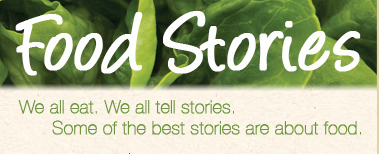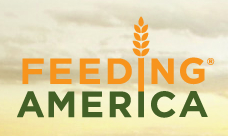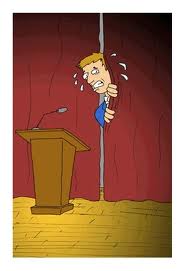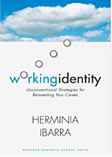
I recently had the most pleasant experience of having Graham Williams, pictured at right, nominate himself and his partner, Dorian Haarhoff, to participate in a Q&A interview. I loved the self-nomination, not only because I knew the pair would be motivated to respond quickly (they did!), but also because I was eager to learn more about The Halo and the Noose. Graham and Dorian are also my first Q&A participants based in Africa. This Q&A will run over the next five days.
Bio: Graham Williams and Dorian Haarhoff run the corporate story 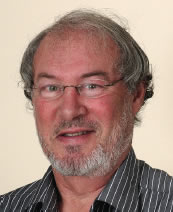 resource web site The Halo and the Noose. They bring a unique blend of business experience, acumen and insight into the role and manner of using storytelling and listening, poetry and metaphor in business life. And impart new outlooks, skill and confidence to others. Part of their mission is to bring healing and possibilities to businesses. The site offers credible, quality resources to an elite readership.
resource web site The Halo and the Noose. They bring a unique blend of business experience, acumen and insight into the role and manner of using storytelling and listening, poetry and metaphor in business life. And impart new outlooks, skill and confidence to others. Part of their mission is to bring healing and possibilities to businesses. The site offers credible, quality resources to an elite readership.
Graham was previously a senior executive with Shell, is a thought-leader for the Institute of Management Consultants, and his formal disciplines are psychology, economics, consumer behaviour, and business economics.
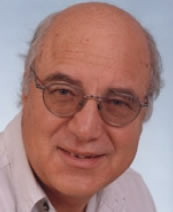 Dorian, pictured at left, is a poet, writer, and mentor steeped in story. A former professor of English, he is a speaker, entertainer, and writing coach.
Dorian, pictured at left, is a poet, writer, and mentor steeped in story. A former professor of English, he is a speaker, entertainer, and writing coach.
They are based in Cape Town, South Africa.
The Halo and the Noose, their first book, was published in 2009 and offers 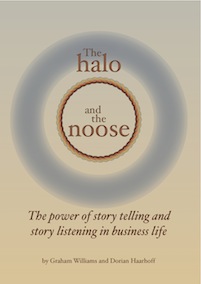 an innovative approach to the stories that beat in the heart of an organization. It addresses techniques and practical applications. At a deeper level the book shows a way of being in business and doing business.
an innovative approach to the stories that beat in the heart of an organization. It addresses techniques and practical applications. At a deeper level the book shows a way of being in business and doing business.
Peter Block, author of Flawless Consulting and partner in Designed Learning: “This is the best book about business and leadership that I have seen in a long time. It is fresh, interesting, needed and written to reach out and touch the toughest part of each of us. This is not just about storytelling, but more importantly, about how we can all change our story and create a future distinct from the past”.
Ralph Windle, author of The Poetry of Business Life and founder/ director of The Creative Value Network: “The authors set out their complex and important themes with an impressive directness and clarity. They achieve this by the simple, persuasive device of practising what they preach. For the narrative moves between argument and story in a seamless way which argues a deep but unobtrusive scholarship in the literatures, cultures and traditions of many societies. The book should be seen as an exciting further step in the long process of re-connecting business life to the mainstream of human history, experience and potential”.
The Halo and the Noose was followed by Story Matters @ Work which deals with applications of story in various corporate functions, at various levels. Mindfulness and imagination are shown to be two key ingredients for effective storytelling and listening.
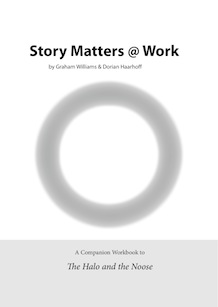 Much of their time is presently being spent on interventions with leading organisations wishing to better use story in order to forge emotional connections with their brand. They assist companies to achieve a triple bottom line — to do well, to be well and to care for the environment.
Much of their time is presently being spent on interventions with leading organisations wishing to better use story in order to forge emotional connections with their brand. They assist companies to achieve a triple bottom line — to do well, to be well and to care for the environment.
Graham and Dorian invite you to connect and converse with them at The Halo and the Noose.
Q&A with Graham Williams and Dorian Haarhoff, Question 1:
Q: Why The Halo and the Noose?
A: Our Orientation for The Halo and the Noose begins: “Stories can free us or trap us. They are like the two-edged sword. It depends on the telling, the motive for the tale and how we interpret the meaning. They can open us to new possibilities or keep us choked by or strangled in existing paradigms and orientations – whether these are about belief systems, values, religions, thinking styles, business and life journeys, strategies or behaviour patterns. Writer Dan McKinnon advises, “A halo has to fall only a few inches to be a noose”. “. The reverse is also true. We acknowledge him for the book’s title. We also dedicate the book to those readers who seek the liberation of the halo and wish to escape the entrapment of the noose……….“
 languages who committed to blog about food for Blog Action Day, October 16, 2011.
languages who committed to blog about food for Blog Action Day, October 16, 2011.




